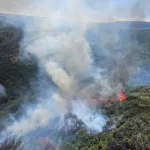Vail gallery owner closes doors, but looks to new projects
mwong@vaildaily.com

Anthony Thornton | athornton@vaildaily.com |
EDWARDS — Jim Tylich leans over an unframed Ovanes Beberian oil painting and carefully examines the image of bright spring flowers sitting in a rounded vase.
“Look at the richness of the color. Also this kind of fat stroke of color on top of another color creates a depth and roundness,” he said, gently touching the surface of a petal.
These are the touches of a master, or maybe a master in the making, he said.
Tylich, of Vail Fine Art Gallery, has made an entire career out of recognizing these qualities, and he’s filled his galleries and office with thousands of works like Beberian’s. After 25 years, he’s closing the doors at his Vail gallery at Solaris. It’s a semi-retirement of sorts, but Tylich will be keeping busy. His Breckenridge gallery will remain open, and his Edwards offices will be open to customers by appointment.
That office, tucked away in a commercial complex, looks completely ordinary at first glance. Inside, Tylich keeps a priceless collection, from museum quality works by modern masters to a Renoir worth millions. Some, like the latter, are under lock and key. There are a number of Soviet era paintings rarely seen outside Russia, alongside American bronze statues and Western style watercolors bursting with color. Other pieces are stacked in drawers and lean amid plastic wrap and frames against the hallways.

Support Local Journalism
The Russian connection
How did a gallery owner amass such a collection?
Tylich will tell you it all started when he was a boy. His father had an appreciation for art and took Tylich and his brothers to every major art museum in the world by the time they were teenagers. He painted himself for a while before turning his attention to collecting. He took a trip to St. Petersburg, Russia, where his family has roots, and got to see art from the country’s best painters. He was amazed and quickly realized that because of the Cold War, many of these artists had never sold their work outside the country.
“Even with the Cold War, art, music, dance and athletics stand on their own in Russia,” Tylich said. “They had some of the best art in the world. When I saw it for myself, I said, ‘I need to bring this home.’”
The task isn’t as easy as it sounds. Many art owners were distrustful of an American buyer, and there were miles of bureaucratic tape to get through in order to legally bring the art into the country. Tylich credits his success to the relationships he forged and the international respect he helped bring to Russian art.
He continued to travel the world, bringing art home from artists he discovered along the way. He helped broker deals for famous works between museums and bought art from war-torn, political hotbeds and became friends with some of the art worlds’ elite.
“One of my first deals was a Renoir, which was the exact size of my carry-on garment bag. I didn’t have a way to bring it back so I ended up leaving the suits and putting the art in the bag,” said Tylich. “The next time I got a big piece of art, I didn’t time it right. I had to walk around several other cities with the art before coming home. I put it in a plastic bag because then it didn’t look like anything valuable. I walked around with a Walmart bag with a million dollar piece of art.”
He laughed, recounting close calls with American-hating crowds, suspicious officials and friends made along the way.
“It’s fun — it’s a hustle, but mainly it’s like making a discovery,” he said of his work.
A discoverer of talent
Tylich hung up his own paintbrushes long time ago, but he found he had an eye for spotting developing talent.
“For example, I was at an art show in Madrid, and I saw a young emerging artist with excellent skill, but no idea what the public wants to buy. I started teaching him what I knew, and finally his works became something that sold for up to $36,000 over a period of time,” he said.
He met another young prodigy, Romanian-American cubist painter Alexandra Nechita, when she was a preteen. He began working with her and telling the world about this emerging talent. He estimates that he’s worked with at least 30 such promising artists throughout his career.
“Fostering artists might be my secondary skill,” he said. “It’s like the football coach who might make a great coach, but can’t play the sport well himself.”
New projects
Tylich opened the Vail Fine Art Gallery in 1989, drawn by the clientele in the area who appreciated the same kind of art that he did. Throughout the years, he opened galleries in Aspen, Breckenridge, Beaver Creek, Taos and Santa Fe. He’s published several comprehensive books on several of the Russian art masters and is also credited with bringing a series of highly successful performances by the Russian ballet to the Vail Valley.
Closing the Vail gallery is bittersweet and brings a sense of nostalgia, Tylich said, but it will also afford him new opportunities. Several clients have already been making calls to the Edwards office, and he has plans to do a major art show in New York City showcasing some of his collection. At 70, he claims it’s time to slow down, but reassures that he’ll still keep doing what he loves.
“I’ve got art from all over the world, and I’m going to sell it slowly out of this appointment-only gallery,” he said.
Assistant Managing Editor Melanie Wong can be reached at 970-748-2927 and mwong@vaildaily.com.










